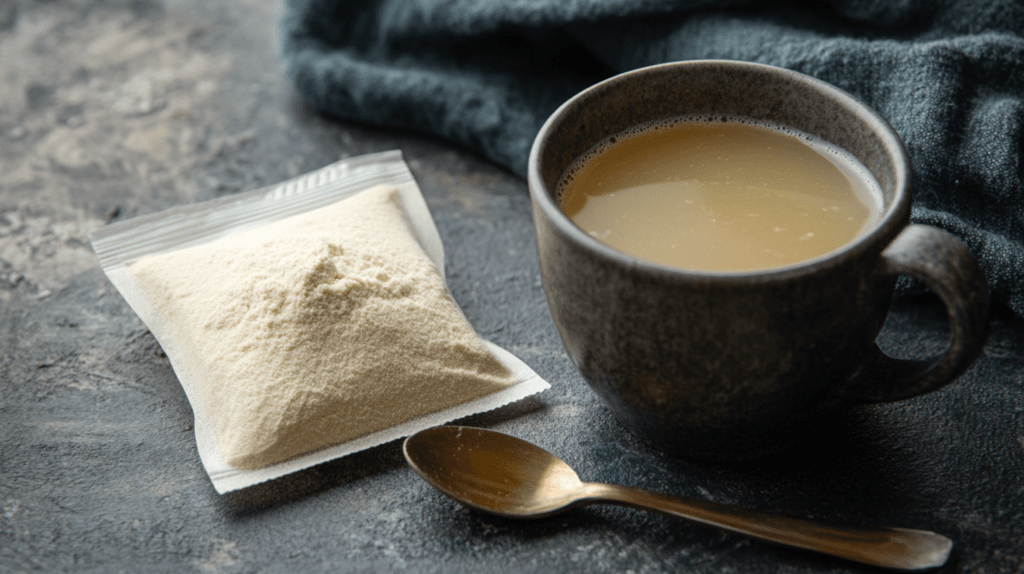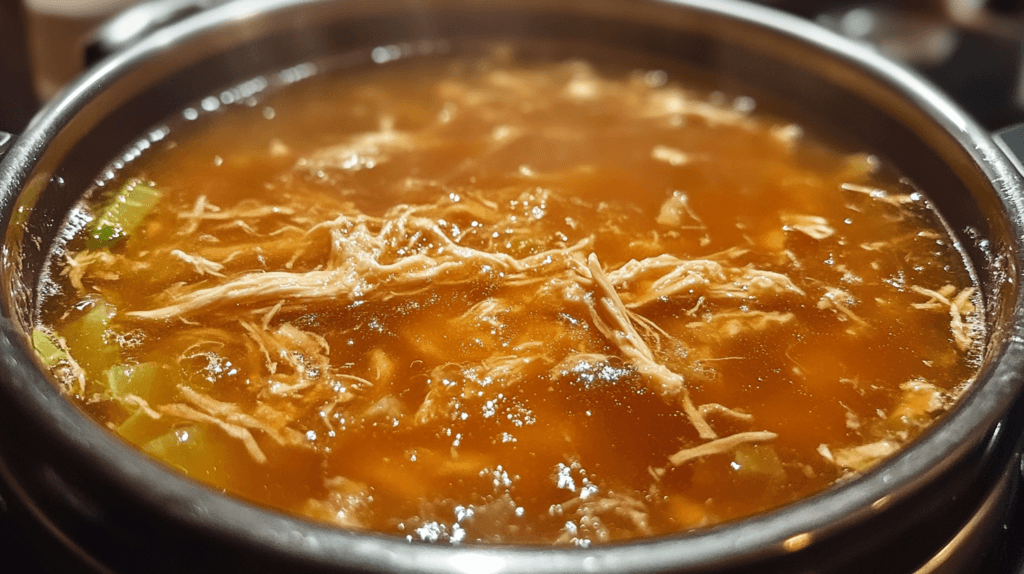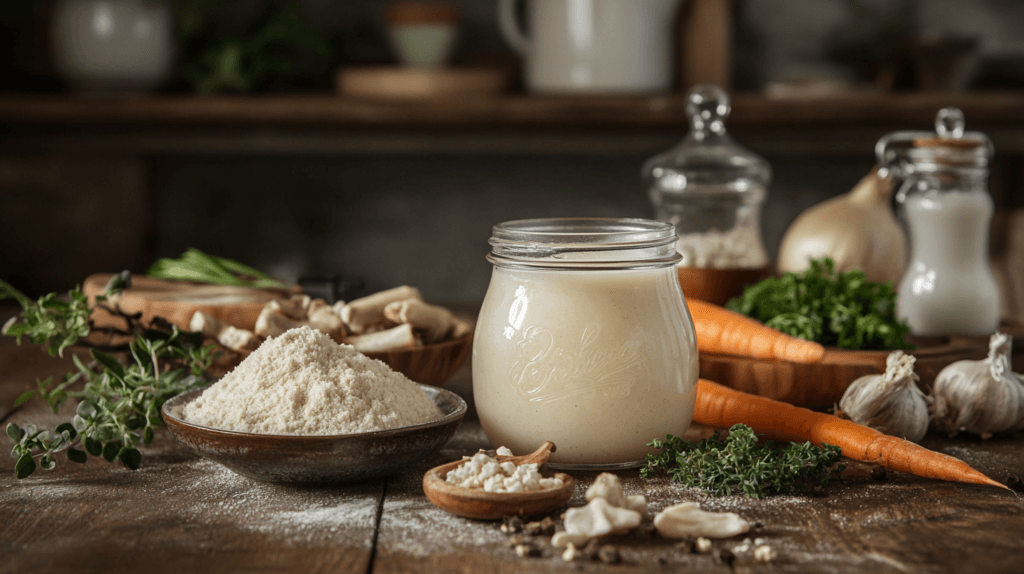Bone broth liquid or powder—both forms of this nutrient-rich superfood have gained immense popularity for their health benefits. Whether you’re using it for collagen support, gut health, or as a flavorful base in meals, understanding the difference between liquid and powdered bone broth can help you decide which one is right for you.
In this article, we’ll explore the key differences between liquid and powdered bone broth, including their benefits, preparation, and suitability for different lifestyles. By the end, you’ll have a clear understanding of which option might work best for your needs.
Table of Contents
Understanding Bone Broth Liquid
What Is Liquid Bone Broth?
Liquid bone broth is the traditional form, made by simmering animal bones, connective tissues, and sometimes vegetables over a long period, typically 12 to 24 hours. The process extracts collagen, gelatin, minerals, and other nutrients, creating a rich and flavorful broth.
How It’s Made
Cooks make liquid bone broth by cooking bones from chicken, beef, fish, or other animals in water. They often add apple cider vinegar to enhance nutrient extraction. For added flavor, they include herbs, spices, and vegetables like carrots, celery, and onions. The simmering process concentrates the liquid, packing it with essential nutrients.
Nutritional Benefits of Liquid Bone Broth
Liquid bone broth is prized for its high nutritional value. Key benefits include:
- Collagen and Gelatin: Supports joint health, skin elasticity, and gut lining repair.
- Amino Acids: Rich in glycine, proline, and glutamine, which promote healing and recovery.
- Minerals: Contains calcium, magnesium, phosphorus, and potassium in bioavailable forms.
Liquid broth is also known for its comforting warmth, making it a popular choice during colder months or when recovering from illness.
Understanding Bone Broth Powder
What Is Powdered Bone Broth?
Powdered bone broth is a dehydrated form of liquid bone broth. The liquid is simmered, concentrated, and then either freeze-dried or spray-dried into a shelf-stable powder. This format offers a more convenient alternative to traditional liquid forms.
How It’s Made
Powdered bone broth production involves several steps:
- Simmering: Similar to liquid broth, the bones and ingredients are cooked to extract nutrients.
- Concentration: The broth is reduced to a concentrated form.
- Dehydration: Producers dry the liquid using advanced methods to retain nutrients and extend its shelf life.
Nutritional Benefits of Powdered Bone Broth
Powdered bone broth retains most of the nutrients found in its liquid counterpart, with the added benefit of convenience. Key advantages include:
- Portability: Easy to carry and store, making it ideal for travel or busy lifestyles.
- Ease of Use: Can be rehydrated into a liquid or added directly to recipes like smoothies, soups, or sauces.
- Nutritional Density: Despite its compact form, it contains the same essential amino acids and minerals as liquid broth.
Comparing Liquid and Powder Bone Broth

When deciding between bone broth liquid or powder, several factors come into play. Below, we’ll dive into the most critical aspects to help you make an informed choice.
Taste and Texture
Liquid bone broth offers a rich, homemade taste with a natural texture, making it ideal for sipping or using in culinary dishes. Its warmth and depth of flavor are hard to replicate in powdered form. Powdered bone broth, while versatile, may lack the robust flavor and can sometimes have a slightly processed aftertaste depending on the brand.
- Liquid Broth: Superior for flavor enthusiasts and recipes where taste is paramount.
- Powdered Broth: Convenient but might require seasoning to match liquid broth’s taste.
Convenience and Storage
Powdered bone broth wins hands-down in terms of convenience. It’s lightweight, portable, and doesn’t require refrigeration before rehydration. On the other hand, liquid bone broth needs refrigeration after opening and can be bulky to transport.
- Liquid Broth: Suitable for home use, where storage isn’t an issue.
- Powdered Broth: Perfect for travel, meal prepping, and busy lifestyles.
Preparation Time
Liquid bone broth is ready to use straight out of the container, making it quick and easy for those who need immediate nourishment. Powdered broth requires mixing with hot water, which adds a small step to the preparation process.
- Liquid Broth: Instant and effortless.
- Powdered Broth: Takes a little effort but is still quick to prepare.
Cost-Effectiveness
Generally, powdered bone broth is more cost-effective because it’s concentrated, and a small amount goes a long way. Liquid broth, while rich in flavor, may require larger servings, making it more expensive over time.
- Liquid Broth: Higher cost per serving.
- Powdered Broth: More economical and longer-lasting.
Shelf Life
Powdered bone broth is the clear winner here, with a significantly longer shelf life. Liquid broth, even when unopened, has a shorter expiration date and requires refrigeration after use.
- Liquid Broth: Best for immediate use.
- Powdered Broth: Ideal for stocking up and extended storage.
Nutritional Content
Both forms are nutritionally dense, offering essential amino acids, collagen, and minerals. However, the nutritional profile can vary depending on the brand and production process.
- Liquid Broth: Naturally nutrient-rich and may offer slightly fresher nutrients.
- Powdered Broth: Retains nearly all the nutrients and is often fortified for added benefits.
Sustainability and Environmental Impact of Bone Broth
As consumers become more environmentally aware, understanding the sustainability of food products like bone broth liquid or powder is crucial. Here’s how liquid and powdered bone broth compare in terms of environmental impact:
Reducing Food Waste
- Liquid Bone Broth: Often made at home or from fresh, local ingredients, liquid bone broth is an excellent way to use leftover bones and reduce waste.
- Powdered Bone Broth: Commercially produced and packaged, powdered bone broth can also contribute to reducing waste by utilizing byproducts from the meat industry.
Packaging and Transportation
- Liquid Bone Broth: Heavier to transport and typically stored in glass or plastic containers, which may require more resources to produce and recycle.
- Powdered Bone Broth: Lightweight and compact, powdered broth uses less packaging material and has a smaller carbon footprint during transportation.
Energy Use
- Liquid Bone Broth: Home preparation can be energy-intensive due to long cooking times, but it minimizes reliance on industrial processes.
- Powdered Bone Broth: Industrial drying methods require significant energy, though they create a longer shelf life and reduce spoilage.
Choosing Ethical Sources
Both forms of bone broth can be sustainable if sourced responsibly. Look for brands that prioritize:
- Grass-fed or pasture-raised animal bones.
- Eco-friendly packaging materials.
- Transparent, sustainable production practices.
Use Cases for Bone Broth
Cooking and Recipes
Liquid broth shines in soups, stews, and sauces, as it blends seamlessly with other ingredients. Powdered broth can be a handy substitute, particularly in dry rubs, marinades, or when a liquid base isn’t needed.
Fitness and Recovery
For athletes and fitness enthusiasts, both forms provide quick protein and amino acid support for muscle recovery. However, the portability of powdered broth makes it a favorite for post-workout shakes and on-the-go recovery.
Gut Health and Digestive Benefits
Bone broth is often used to soothe digestive issues and promote gut lining repair. Both forms work equally well for this purpose, but liquid broth may feel more comforting when consumed warm.
Beauty and Skin Health
The collagen in bone broth helps improve skin elasticity and hydration. Whether you opt for liquid or powdered form, the benefits for hair, skin, and nails are the same, though powdered versions are easier to include in daily routines.
Which Is Better for You?

The choice between liquid and powdered bone broth largely depends on your lifestyle, preferences, and health goals. Both forms offer distinct benefits that suit different needs.
Factors to Consider: Lifestyle and Goals
- Convenience:
- If you’re often on the go, powdered bone broth is more practical. It’s lightweight, easy to store, and can be prepared anywhere with access to hot water.
- Liquid broth is ideal for those who mainly consume it at home and prefer a ready-to-use option.
- Taste Preferences:
- Liquid bone broth provides a richer, more authentic flavor, making it perfect for sipping or adding depth to recipes.
- Powdered broth may be less robust but can be customized with additional spices or herbs.
- Health Goals:
- For those focused on joint health, beauty, or recovery, both forms provide comparable benefits. The choice depends on whether you prioritize portability or traditional preparation.
- Budget:
- Powdered bone broth is generally more affordable over time, particularly for daily use.
- Liquid broth offers a more luxurious feel but tends to be more expensive per serving.
Expert Recommendations
Health experts suggest evaluating the specific circumstances of your diet and routine. For instance:
- Fitness Enthusiasts: Powdered bone broth is ideal for its portability and convenience, making it easy to mix into smoothies or post-workout drinks.
- Culinary Uses: Liquid bone broth is perfect for recipes where flavor and texture are key.
- Daily Supplementation: Either form can work, but powdered broth offers greater versatility for consistent intake.
Environmental Impact of Bone Broth: Liquid vs. Powder
Understanding the environmental impact of choosing between liquid or powdered bone broth can guide you in making a more sustainable decision. Here’s a breakdown:
Packaging
- Liquid Bone Broth: Usually packaged in large containers like plastic tubs, glass jars, or tetra packs, liquid bone broth tends to produce more waste. Some of these materials are challenging to recycle, leading to increased landfill waste.
- Powdered Bone Broth: Packaged in lightweight, resealable pouches or jars, powdered bone broth uses less material overall. It is also more space-efficient for shipping, reducing carbon footprints.
Transportation
- Liquid Bone Broth: Being heavier and bulkier, liquid broth requires more energy for transportation, which results in higher emissions.
- Powdered Bone Broth: Lightweight and compact, powdered broth is more eco-friendly and easier to transport.
Storage
- Liquid Bone Broth: Requires refrigeration after opening, leading to higher energy usage at home.
- Powdered Bone Broth: Shelf-stable and requires no refrigeration, making it a more energy-efficient option.
Production
Both liquid and powdered broths require energy-intensive simmering processes. However, the dehydration process involved in making powdered broth increases its energy consumption, somewhat reducing its environmental benefits in other areas.
Frequently Asked Questions
Can you mix bone broth liquid and powder?
Yes, you can mix them if you want to combine the benefits of both. For example, adding powdered broth to liquid can enhance its nutrient density or adjust the flavor profile.
Does powdered bone broth have the same taste as liquid?
Powdered broth is similar in taste but may not have the same depth and richness as liquid broth.. Brands differ, so experimenting with seasonings or choosing high-quality products can help improve flavor. For seasoning inspiration, check out our guide on essential ingredients for rich broths.
How long does each type last after opening?
- Liquid Broth: Generally stays good for 3–5 days in the refrigerator after opening.
- Powdered Broth: Powdered bone broth remains shelf-stable for months if you store it in a cool, dry place. This makes it a handy addition to recipes like our quick and healthy meal preps.
Can you cook with powdered bone broth?
Absolutely! You can rehydrate powdered bone broth for soups or add it directly to dry recipes like rubs, marinades, or baked goods to boost their nutrition.
Is powdered bone broth less healthy?
No, powdered bone broth retains most of the nutrients present in liquid broth. The drying process helps preserve amino acids, collagen, and minerals, although some may feel that liquid broth tastes fresher.
Are there vegan alternatives to bone broth?
Yes, vegan alternatives like vegetable-based broths with collagen-boosting ingredients (e.g., seaweed, mushrooms, and nutritional yeast) are available. They don’t contain collagen but still offer nutrients for gut and skin health. Read about vegan-friendly broth options to diversify your choices.
Conclusion
Choosing between liquid or powdered bone broth comes down to your personal preferences and needs. Liquid bone broth provides exceptional flavor and a comforting experience, making it perfect for traditionalists or home cooks. On the other hand, powdered bone broth shines in convenience, portability, and long-term storage, making it an excellent option for those with busy schedules or a tight budget.
Whichever you choose, both forms are excellent sources of collagen, amino acids, and essential nutrients that support overall health and wellness. The best choice is the one that seamlessly fits into your routine and helps you achieve your health goals. For a deeper dive into meal inspiration and preparation tips, explore our collection of wholesome recipes.

